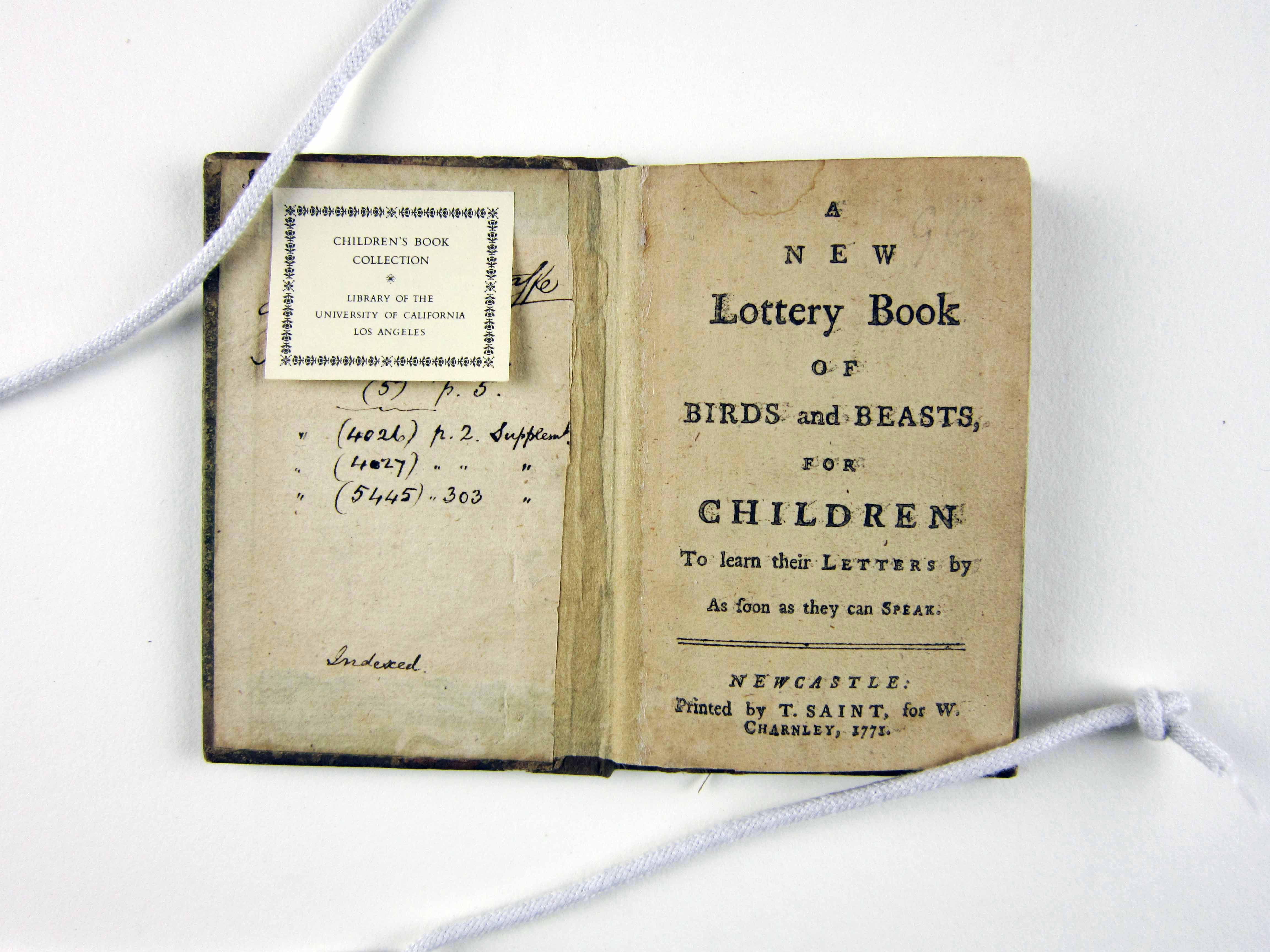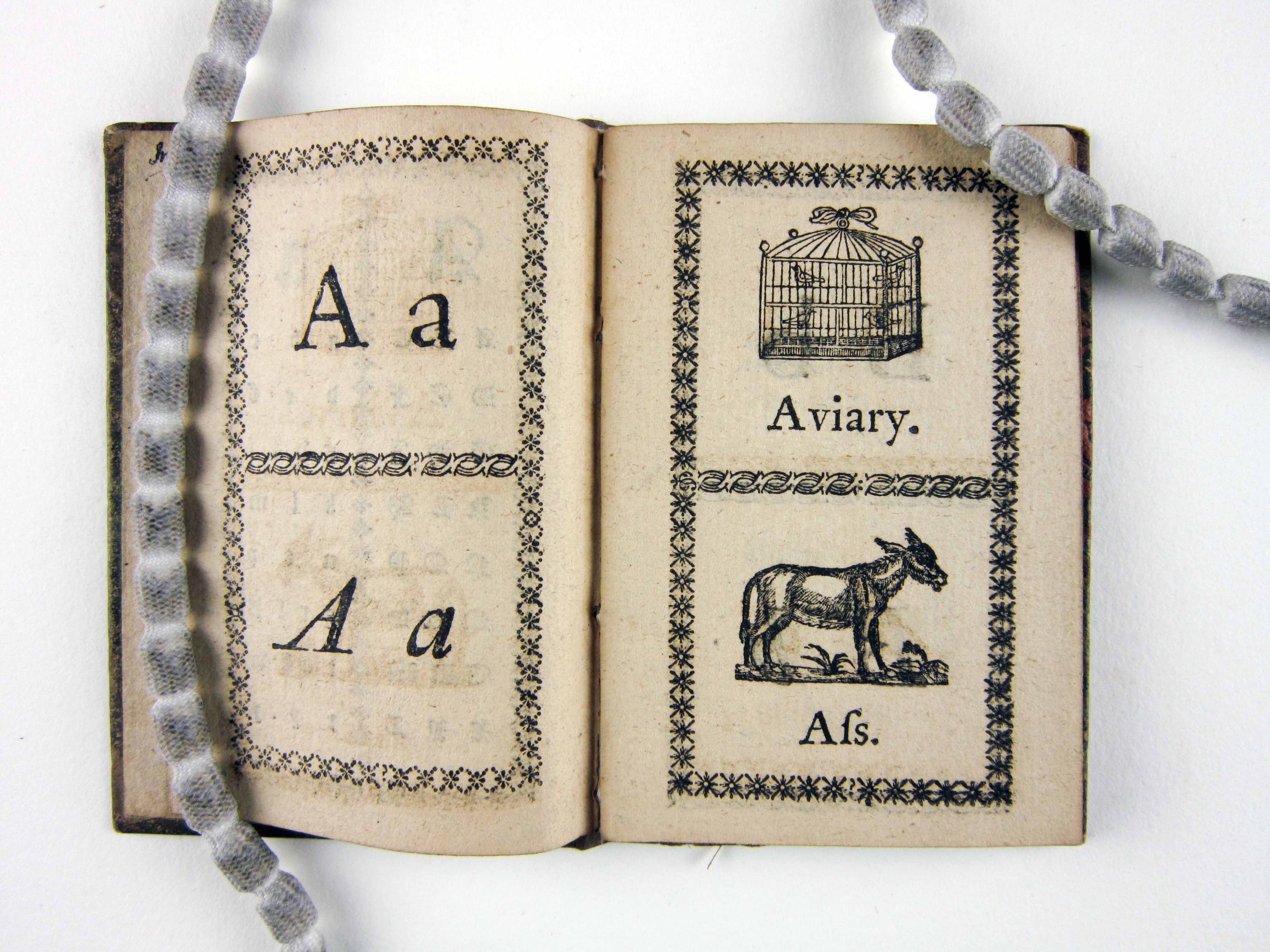

Alphabet books offer a vivid insight into the history of literacy and culture, as well as concepts of childhood. The Children's Book Collection at UCLA contains a rich array of these materials, some well-worn and much-used, some still bright and fresh. Each is a gem of print production and graphical imagery from another time and place. Though the history of alphabet books continues to the present, this exhibit focuses on the works in our collections published between 1700 and 1900, including horn books, primers, works of didacticism and seriousness, whimsy and play.
2. A Jumble ABC
3. A Little Pretty Pocket-Book
4. A New Lottery Book of Birds And Beasts
5. A Pretty Play-Thing for Children of All Denominations
8. ABC of Objects for Home And School
10. ABC with Pictures & Verses
12. Alphabet Et Instruction Pour Les Enfans
16. Dolly's ABC Book
17. Flora's ABC
18. Home ABC
22. Hornbook C. 1700
23. Large Letters for the Little Ones
24. Little ABC Book
25. Little People: An Alphabet
26. Martin's Nursery Battledoor
27. Mother Goose ABC
28. My Darling's ABC
29. Orbis Sensualium Pictus Quadrilinguis
30. People of All Nations: A Useful Toy for Girl Or Boy
31. Picture Alphabet
32. Pretty ABC
33. Railway ABC
34. Rusher's Reading Made Most Easy
38. The Alphabet of Old Friends
40. The Amusing Alphabet for Young Children Beginning To Read
42. The Child's Christian Education
45. The Easter Gift
47. The Favorite Alphabet for the Nursery
49. The Franklin Alphabet And Primer
51. The Golden ABC
55. The Moral And Entertaining Alphabet
57. The Old Testament Alphabet
59. The Picture Alphabet for Little Children
62. The Sunday ABC
63. The Union ABC
64. The Young Child's ABC, Or, First Book
65. Tom Thumb's Alphabet: Picture Baby-Books
67. Warne's Alphabet And Word Book: with Coloured Pictures
68. Wood's Royal Nursery Alphabet
Title A New Lottery Book of Birds And Beasts


Brief description Original Dutch floral boards.
Full description A New Lottery Book of Birds and Beasts is a small book, which could be easily held by a child or slipped into a pocket. This copy of the book is fragile and is housed in a small case.
In addition to the case, the book has two covers or outer coverings. The outer cover (or top layer) is a mottled green with black edging. The words Lottery Book along with the year 1771 are on the spine. The inner cover is dominated by a flowery design. This sixty-page book consists mostly of the alphabet, although there is a small section after the alphabet that contains lessons on syllables and lists of lessons on behavior.
In the alphabet portion of the book, there are two boxes, one above the other, on each page. On the left page, the top box contains standard upper- and lowercase letters, and the bottom box includes the letters italicized. On the facing page, the boxes contain an illustration of an animal starting with the corresponding letter of the alphabet, as well as a label for the illustration.
After the alphabet is finished, the pages no longer have boxes, but lists of vowels, consonants, double letters, and an exercise on the letters. Each of these is repeated in italic. After this, there are lessons on syllables. Finally, there are 15 lessons on behavior and learning. The pages after the alphabets are not illustrated, and there are no page numbers.
Literacy A New Lottery Book of Birds and Beasts tells us that literacy during this period was something that should be learned as soon as children were capable of verbal expression. Letters here are learned by matching pictures and animals. The book also teaches syllables, words, and full sentences for children to read.
This book focuses more on literacy of word, although much care is given to the wood engraving illustrations. These illustrations depict animals and put some emphasis on visual literacy. Because of the realism of the images of familiar animals, the children can trust that the tiger is depicted accurately, even if they have never seen one before.
At the end, there is a small focus on behavioral literacy. There are some lessons on how children should behave included. For example, the first lesson is, He that is a good Boy, and will mind his Book, all will love him. But if he is bad, and will not learn, no one will love him. This shows the importance placed on literacy. The references to God also give a brief taste of religious emphasis.
Childhood This book is targeted towards younger children to learn their letters by as soon as they can speak. However, given that there are syllable and behavioral lessons at the end of this book, it is quite likely that children could use this book as they learn how to read sentences and can better discern what is and it not moral. It is a very small book so that a child might slip the book in their pockets enabling them to learn anywhere.
The lessons are very serious and religious (He that is a good Boy, and will mind his Book, all will love him. But if he is bad, and will not learn, no one will love him.), indicating that both learning and God should be important to the children using this book.
The idea of childhood in this book is that of children as miniature adults. Childhood is a serious time, for children to learn knowledge and traits that would help them become productive adults. It is a time to learn, but learning here is strictly utilitarian. The text and images all relate to educational tools and instructions on behavior rather than encouraging creative thinking or amusement.
Iconography A New Lottery Book of Birds and Beasts was printed in Newcastle but there is no iconography that is specific to England. The book depicts a variety of animals, ranging from everyday animals, such as cats, to exotic animals like the tiger.
Thomas Bewick, a renowned printmaker and ornithologist, illustrated the book, which accounts for the number of birds represented. The number of farm animals (such as a sow and a bull) could indicate an audience more centered in a rural economy.
While A New Lottery Book of Birds and Beasts was printed in England, not all of the animals would be readily found in England. The ibex and the lion are two examples of this. By introducing readers to these animals, this book helps to expand the worldview of its audience.
Production This book was printed in 1771 in Newcastle by T. Saint for W. Charnley. The printing is smeared and a little sloppy. One defining feature of this book is the woodcut illustrations by Thomas Bewick. Bewick, who was a printmaker, engraver, and naturalist, helped establish wood engravings as an important printmaking technique in children's literature.
Before Bewick, there were two main techniques used in illustrating books: engravings, which were more costly to produce and limited to more expensive books, and woodcuts, which were fairly crude in comparison to what followed. Publishers and printmakers of cheaper books used woodcuts. Often, they would use whatever woodcuts were at hand, writing the text to fit the illustration, which could sometimes lead to confusing and somewhat disjointed books.
Thomas Bewick helped change the course of illustration in children's books when he developed the technique of wood engraving. While woodcut illustrations were done along the grain of the wood, he engraved his illustrations into the end-grain. This allowed him to draw a finer line and add more subtle detail and effects. While the illustrations in this book are woodcuts and not wood engravings, they are still significant because they show the artistry and detail that he became famous for.
Creator Thomas Bewick
Publisher Printed by T .Saint for W. Charnley
Publication place Newcastle
Date 1771
UCLA Call Number CBC PE1119.A1 N835 1771
Repository UCLA Charles E. Young Research Library, Dept. of Special Collections
Technologies of production Woodcut (process)